|
For Part 2 of this series, we are going to be exploring cool gear hacks and workarounds to get you rolling on a low budget. In this series as a whole, we will be discussing everything from DIY electronic builds, to great inexpensive products you may not have heard of before. With that said, let's get rolling with our first project: DIY ELECTRIC GUITAR BUFFER/LINE DRIVER/BOOST If you run an electric guitar amplifier in a remote & isolated location several feet from your guitar amplifier, this buffer/linedriver is a killer solution for curing any capacitance issues you may have with your rig - thus preserving your tone. As many of you already know, the longer the 1/4" run, the more capacitance in your guitar's signal chain, and the duller the tone. This circuit cures this issue, and has no negative effects. This ultra-simple circuit sounds so good, you'll want to leave it on all of the time. I have compared it against some of the most well known manufactured devices, and it is easily the best. Notice that I use an LM386 IC. Yes, this chip was originally developed by Texas Instruments as a 1/2 watt amplifier, but with a little know-how, and leaving out certain parts of the circuit, it makes a killer transparent boost.  The .1uf capacitor can be a cheap ceramic cap. Don't worry, your guitar won't know the difference, and neither will anyone else. The output volume control, is a 1/2 watt 100k Audio Taper potentiometer. Set the output volume of the circuit to where the tone is boosted just a hair, and this is where this buffer/linedriver is operating at its optimum level. Too much boost (which this circuit can easily do), and you'll overdrive the input of your guitar amplifier (some folks like this). Add a 3PDT stomp switch to make this a boost. If you need an enclosure, I recommend Small Bear or Pedal Parts Plus. The total project cost is not more than $20. Super cheap & super easy to build with extraordinary results.  My personal pedalboard with the above circuit as a boost/linedriver (upper left-hand corner). I used to be the chief designer of boutique guitar pedals from 2008-2011 of a now defunct pedal company. This pedal was my very first prototype of this type of pedal. I built it out of spare parts ( that's why it's so ugly - Lol ). When I tested it out, I noticed it imparted a certain "something" to my tone that I loved. It's stayed on my board ever since.
0 Comments
Your comment will be posted after it is approved.
Leave a Reply. |
Do you like vintage recording gear and articles? You should visit our sister site: The Vintage Audio Portal!
**Advertise With Us! We have thousands of visitors a day. Contact us here to learn more.
Archives
August 2021
Categories |

